
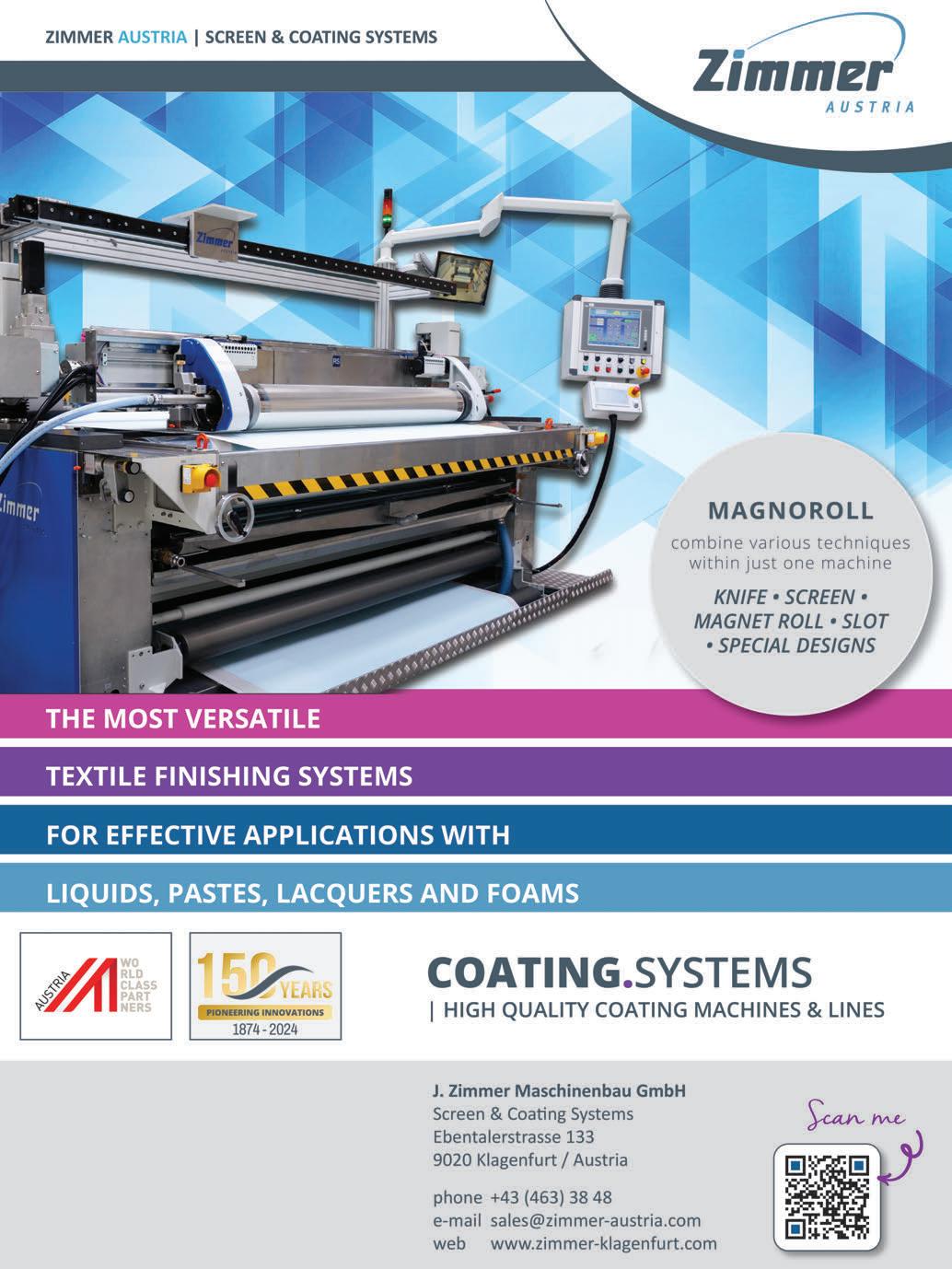
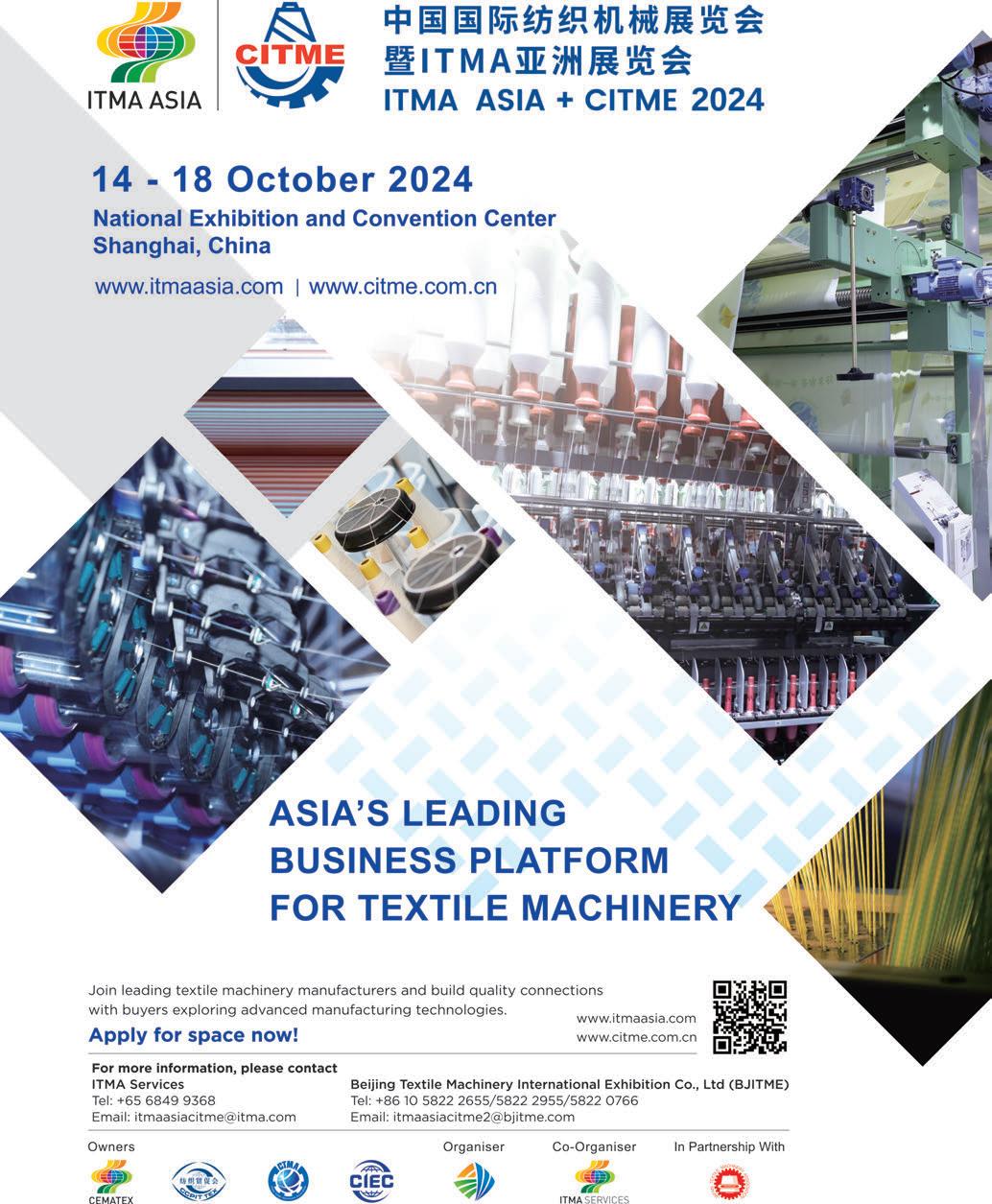


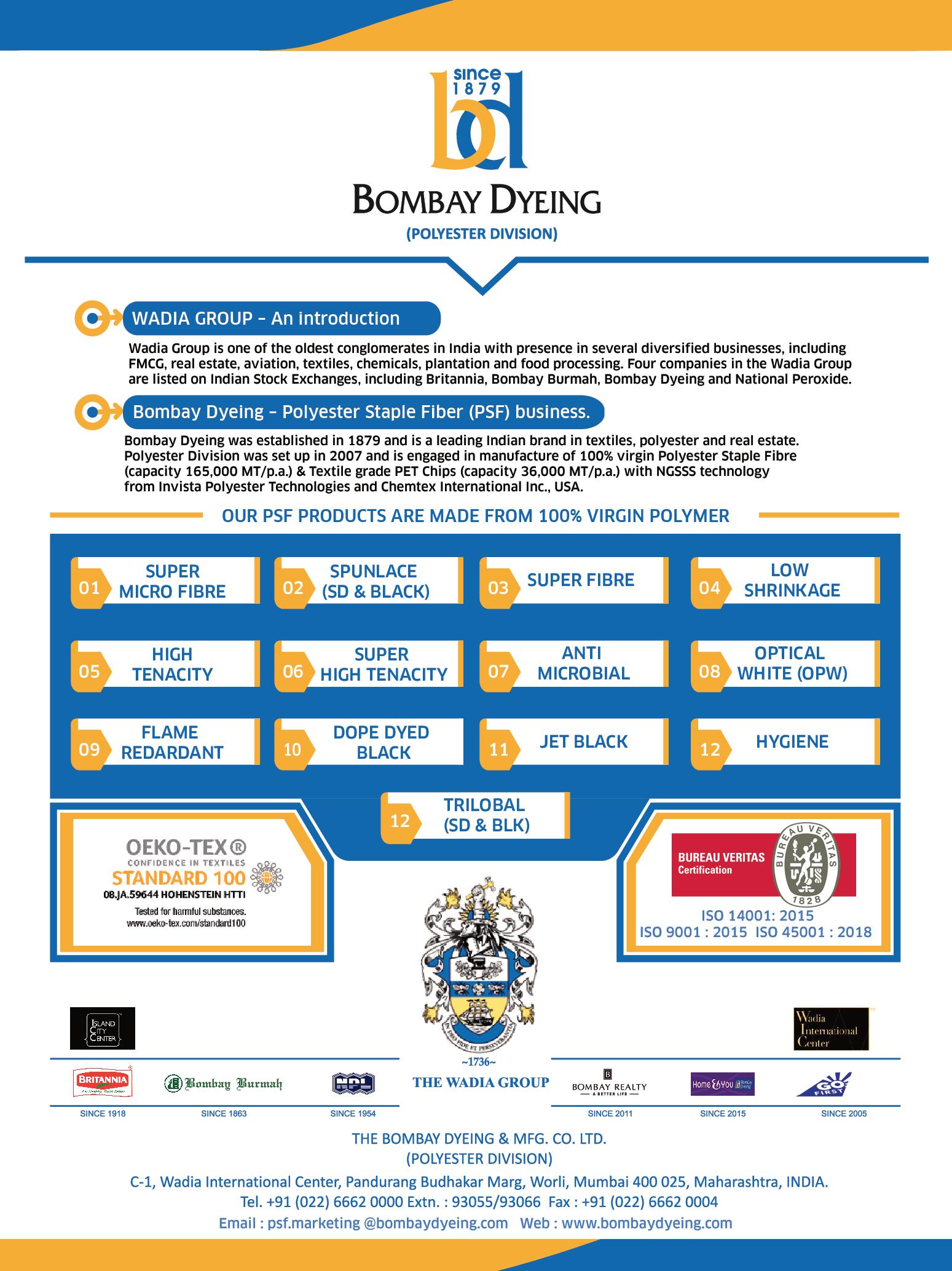
Editorial








Editorial
ETVislookingtothefuturewithMonforts
AIintheTextileIndustry:Opportunities,Challenges,andtheFutureofWork
RE&UP:RevolutionizingTextile-to-TextileRecyclingforaSustainableFuture
InnovativeHemp-BasedCellulosicFilaments: SustainabilityandHigh-PerformanceTextileSolutions
Low-CarbonandSustainableInnovationinthePETFiberIndustry
SamsaraEco:PioneeringInfinitePlasticRecyclingforaSustainableFuture
Syre:RevolutionizingTextile-to-TextileRecyclingforaGreenerFuture
DrivingInnovationandGrowth:ITTA’s14thAGMHighlights theFutureofTechnicalTextilesinIndia
INDAandEDANAForgePathTowardsStrategicAllianceto AdvancetheGlobalNonwovensIndustry
KARLMAYERGROUPtoShowcaseCutting-EdgeWarpKnittingSolutions atITMAASIA+CITME2024
Monfortsis140andlookingtothefuture
DILOreceivesawardforthenewdevelopment“MicroPunch”
EmtecElectronictoUnveilGroundbreakingHapticTestingTechnologyatTITAS2024
Digitalsolutionsforthechallengesofwarpknittingandknittingmills
BWConverting’sBaldwinUnveilsTexCoat™G4atITMAAsia2024: LeadingtheWayinSustainableTextileFinishingwithMonfortsandArchroma

editor-in-chief
Prakashkinny contributor
ThomasChang circulation PamelaJones administration JoePereira accounts
RameshJain photography
TonyFernandes
RetailPrice:Rs.100.00 InsideIndia
Annualsubscription:Rs.400.00 OutsideIndia
AnnualSubscription:US$30.00
editorial office
TECHNICALTEXTILESINNOVATION
House No. 157, Satpala, Bhandra Lee Post:Agashi, Tal: Vasai
Dist: Palghar (401 301)
State: Maharashtra, INDIA
Mobile: +91-7798189485/09892723562
Email:info@timesinternational.in prakashkinny@yahoo.com techtexin@gmail.com
www.timesinternational.in
JAPAN
KatsuhiroIshii
MediaRepresentative ACEMEDIASERVICEINC. 12-6,4-chome,Nishiiko,Adachi-ku, Tokyo121-0824Japan
Tel:81-3-5691-3335Fax:81-3-5691-3336 amskatsu@dream.com
TAIWAN,R.O.C
Kenlychang
BUILDWELLINTERNATIONALENT.,CO.,LTD.
HeadOffice:No.120,Huludun2ndSt., FongyuanCity, TaichungCounty42086,Taiwan,R.O.C
Tel:886-4-25123015Fax:886-4-25122372
E-mailaddress:buildwel@ms23.hinet.net
India,Pakistan,Bangladesh,Srilanka,Vietnam,Indonesia,Thailand, China,HongKong,USA,Germany,Spain,Italy,U.K.&France

As global demand for nonwoven fabrics continues torise,Thailandiscementingitspositionasaleader in Southeast Asia's nonwoven industry. With an impressive 48% market share in the region, Thailand'sroleinthesectorissettotakecenterstage attheinauguralAsiaNonwovensTechnologyExpo (ANTEXAsia 2024) from November 13-15, 2024, inBangkok.
Thailand's nonwoven fabric market is flourishing, drivenbyinnovationandashifttowardsustainable technologies. The country's production capacity of 162,000 tonnes per year makes it a regional powerhouse.ANTEXAsia2024willshowcaseover 100 exhibitors from 10 countries, presenting cutting-edgematerials,technologies,andsolutions. Industry experts and leaders like Dr. Chanchai Sirikasemlert of the Thailand Textile Institute emphasizetheimportanceofsustainableproduction andthecountry'sreadinesstobecomeamajorexport hub.
Alongside the Expo, theANTEXAsia Nonwovens Conference 2024 will explore emerging trends, including healthcare and circular economy applications.
With key players like Teijin and Narula participating, ANTEX Asia 2024 offers a premier networking platform for industry stakeholders. As the nonwoven industry expands into sectors like automotiveandhealthcare,Thailand'sleadershipin sustainable innovation continues to gain global recognition.
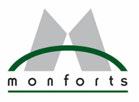
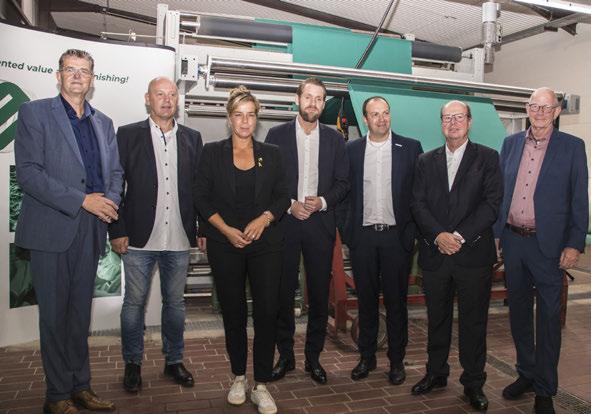
At a time when European commission finishers arefindingitincreasinglydifficulttooperatedue to extremely high overheads, ETV, based in Gescher, Germany, is going from strength to strength – and alert to new opportunities going forward.
Founded in 1950, the privately held company is currently installing a third Monforts Montex 8500 finishingrangewithaworkingwidthof3.2metres, fullyequippedwithaMontex®Coatcoatingunit,an EcoBooster heat recovery unit, crash calender and computer-controlledwindersandunwinders.
For ETV managing director Dirk Tunney, the company'slongevityisinpartduetoatimelymove away from traditional textile applications such as clothingandhometextiles25yearsago,tofocuson addingvalueandfunctionalitytotechnicaltextiles, filmsandmembranes.
“The large discounters now dominate the procurement markets, particularly in the home textiles sector,” he says. “Stationary retail hardly exists anymore and the market is characterised by the price structure of cheap imports from nonEuropeancountries.”
Since repositioning itself in 1999, ETV has grown intoapowerhouseinitsselectedfields,dyeingand finishingaround1,500tonsofyarnand1.6million linear metres of fabric each year. In addition, the company annually prints around 4 million linear metres of fabrics, foils and membranes, along with coatingupto40millionlinearmetresoffabricsand nonwovens.
ETV was also early in addressing the need for sustainable processes with a thermal exhaust air aftertreatmentunit,aprintingpasterecyclingstation and the use of 100% recycled industrial water as a result of its own in-house water and sewage treatmentplant.
EscalatingenergycostsinGermany,however,have understandably been a cause for concern for the company.
“Uptoandincluding2020,ourenergyexpenditure was less than 10% of our total overheads which ensured we were competitive on the market, but at their peak in 2022, gas prices in Germany had increased tenfold and electricity prices increased fivefold,”Tunneysays.“Ourindustrytodayhastolive withelectricitypricesthatareapproximatelytwiceas

highandgaspricesthatareapproximatelythree-anda-halftimeshigherthanbefore2021.Inthefuture,we areassumingalevelof12-13%sowearetalkingabout additionalexpenditureofupto€400,000dependingon ourfutureproductproductionprogramme,whichasa contractprocessorwehaveonlyalimitedinfluenceon.
“EnergyiscertainlynolongercheapinGermanyand wehavemovedfrombeinganexporterofelectricityto an importer and will no longer be able to supply ourselvesinthefutureifwedon`tchangeanything.It's worrying that without our European neighbours our lightswouldsometimesgoout.”
Monforts Montex stenters are now industry standard for the fabric finishing industry, providing many advantages in terms of production throughput and especiallyinenergyefficiencyandsavings.
The Monforts Eco Booster, integrated into the chamber design of ETV's Montex stenter, is a single heatrecoverysystemwithautomaticcleaningthatcan further save up to 35% in energy costs. The Eco Booster consumes only minimal amounts of water during the cleaning cycle and the entire process is controlledandmonitoredautomatically.
® The MontexCoat serves a very diverse number of markets and enables full coatings, pigment dyeing or minimal application surface and low penetration treatments to be carried out. Knife coating, roller coating or screen printing can also all be accommodated with this system. In addition, the Montex®Coatprovidestheultimateinflexibilityand theabilitytoswitchquicklyfromonefabricruntothe next,withoutcompromisingontheeconomicaluseof energyorrawmaterials.
“Wecertainlyanticipateenergysavingsinadditionto increasedproductivityandprocessreliabilitywiththis latest line and in addition, we will be working with Monfortsonalternativeenergyoptions,”Tunneysays.
Monforts is currently leading a consortium of industrial partners and universities in the three-year WasserSTOFF project, launched in November 2022, toexploreallaspectsofthisfast-risingnewindustrial energyoption.
The target of the government-funded project is to establish to what extent hydrogen can be used in the future as an alternative heating source for textile finishing processes. This will first involve tests on
laboratory equipment together with associated partners and the results will then be transferred to a stenter frame at the Monforts Advanced Technology Center(ATC)inGermany.
“Green hydrogen's potential as a clean fuel source is tremendous, but there is much we need to explore when considering its use in the textile finishing processescarriedoutgloballyonourstenterdryersand other machines,” says Monforts Managing Director Gunnar Meyer. “Everybody knows that textile finishing is a high energy consuming process and to make the processes more efficient, we already offer several solutions, but as a technology leader we are also rising to the challenge of exploring alternative heatingoptionstobereadyforthefuture.”
ETV'srelativeproximitytotheMonfortsheadquarters in Mönchengladbach makes it an ideal site for the WasserSTOFFproject.
“The project for a hydrogen-powered coating stenter frame is very suitable for our region,” says Tunney. “Germany's textile industry has a long tradition and withmorethan1,400companies,isnotunimportantto the country, but without support from politics, both ideologically and financially, something like this cannotbedone.
“Ifwewantdecarbonization,pathsmustbeidentified and funds made available. We absolutely have to remain open to technology in order to position ourselves in the best possible way. Otherwise it will result in deindustrialization, which none of us want. We look forward to a closer collaboration with Monfortsanditsprojectpartnersgoingforward.”
th OnSeptember6 thisyear,Germany'sEconomicsand Climate Protection Minister Mona Neubaur visited ETVtogetafirst-handviewofhowthetextileindustry israpidlyadaptingtoachanginglandscape.
“The future of German industry will be decided in North Rhine-Westphalia,” she said. “This requires courageous companies to move forward. Innovative ideas strengthen our competitiveness and make a significantcontributiontobecomingthefirstclimateneutral industrial region in Europe. Green hydrogen willplayanimportantroleinthisandIamverypleased that through companies like ETV and Monforts and their partners, we are now moving quickly from preparationtoaction.”

Introduction
Artificial Intelligence (AI) is rapidly transforming industries worldwide, and the textile industry is no exception. In his presentation at the ITMF & IAF Joint Conference 2024, Prof. Thomas Gries from the Institut für Textiltechnik (ITA) at RWTH Aachen University explored the impact ofAI on the global textile industry. This report summarizes his insightsonhowAIcanrevolutionizethetextilesector, address the skills shortage, and shape the future of work.
TheCurrentSkillsShortage:AGlobalChallenge
Oneofthemostpressingissuesacrossindustriesisthe growingskillsshortage,whichisprojectedtoworsen due to demographic changes and evolving technological demands. The textile industry is particularly vulnerable to this shortage as it relies heavilyonbothmanuallaborandtechnicalexpertise.
Keyfactorscontributingtotheskillsgapinclude:
· Agingworkforce:Asexperiencedemployees retire, they take valuable knowledge with them,creatingagapinexpertise.
· Lack of new talent: Many industries, including textiles, struggle to attract younger workers, leadingtogaps inkeyareassuch as AIanddigitalization.
AIasaSolutiontotheSkillsGap
AItechnologyoffersasolutiontomitigatetheeffects of the skills shortage by automating repetitive tasks and enhancing productivity. Companies that fail to adopt AI technologies are at risk of becoming noncompetitive by 2030, as automation becomes increasinglynecessaryforsurvival.
AIcan:
1. Automate up to 70% of repetitive tasks in production, reducing dependency on human labor.
2. Enhance decision-making through data analysis, enabling companies to respond fastertomarketdemands.
3. Support knowledge transfer by capturing and storing the expertise of retiring workers, ensuringthatvaluableinformationisnotlost.
The textile industry has been slow to embrace digitalization, but the integration of AI offers a pathway to improved flexibility and efficiency in production. By leveraging AI, manufacturers can
speeduptimetomarket,reducewaste,andimprove productquality.
KeyapplicationsofAIintextilesinclude:
· Predictive maintenance: AI systems can monitor machinery performance, predict breakdowns, and optimize maintenance schedules,reducingdowntime.
· Supply chain management: AI helps optimize inventory, track shipments, and forecast demand, leading to more efficient supplychains.
· Customization:AIenablestheproductionof customized textiles on demand, meeting the growing consumer demand for personalized products.
The integration of AI in the textile industry also has implications for workforce transformation. As repetitivetasksbecomeautomated,theroleofworkers will shift toward more strategic and creative tasks. However, this transformation requires investment in education and training to equip workers with the necessaryAI-relatedskills.
At RWTH Aachen University, the National Competence Center Digital – Smart Circularity is working on innovative AI-based training programs. These programs provide workers with real-time simulations of textile production processes, allowing them to develop new skills in a safe, controlled environment.
Conclusion:ACalltoEmbraceAIforaSustainable Future
The textile industry is at a crossroads, facing both significant challenges and tremendous opportunities. AI offers a solution to many of the industry's current problems, from the skills shortage to the need for increased efficiency and sustainability. However, the successful adoption of AI requires collaboration acrossthesupplychain,investmentineducation,and acommitmenttodigitaltransformation
Prof. Thomas Gries concluded his presentation by urgingindustryleaderstoembraceAIandinvestinthe future of their workforce. By doing so, the textile industry can not only survive but thrive in an increasinglycompetitiveandautomatedworld.


Authors:
· Andreas Dorner (General Manager, RE&UP)
· Ozgur Atsan (Chief Commercial Officer, RE&UP)
Introduction
The textile industry faces an unprecedented waste crisis, with over 100 million tons of textile waste produced in 2023, most of which is destined for landfills or incineration. Recognizing the need for immediate action, RE&UP has introduced a groundbreakingsolutiontoaddressthetextilewaste problembyofferinghigh-quality,traceable,recycled raw materials such as cotton fibers and polyester chips. This report outlines RE&UP's technology, processes,anditsimpactonclosingthematerialgap inthetextilerecyclingsector.
According to the Ellen MacArthur Foundation and the European EnvironmentAgency, over 31 million tonsofrecycledfiberwillbemissingby2030.With increasing regulatory pressures such as Extended
Producer Responsibility (EPR) and eco-design directives, brands are seeking sustainable solutions. RE&UP addresses this challenge by providing a fully scalable, circular recycling process that turns textile waste into virgin-quality materials without disruptingexistingsupplychains.
RE&UP is a pioneer in textile-to-textile recycling, offering a one-stop, closed-loop solution that processes various types of textile waste, including pre-consumer and post-consumer waste. Its unique technology separates blended fabrics, enabling the recycling of cotton-heavy, polyester-heavy, and polycottonblendsintotraceable,ready-to-usefibers andchips.
KeyFeatures:
· RecycledCottonFibers:Withameanfiber lengthof20mmanddustcontentoflessthan 2%, these fibers are suitable for Open-End (OE), Ring spinning, and non-woven manufacturing.
· Recycled Polyester Chips: Weighing 2.3-
2.5g/100pieces,thesechipshaveaviscosity of 0.66 dl/g and are ideal for continuous filament yarn spinning and staple fiber spinning.
· Sustainability: The RE&UP process reduceswateruseby90%,climateimpactby 28%, and land use by 75% compared to virginmaterials.
RE&UP's innovative approach not only provides recycled materials but also ensures minimal waste. Its thermo-mechanical recycling process separates fibers and recycles polyester and cotton, leaving almost no residual waste. For cotton recycling, RE&UP even produces by-products like cellulosic powder, further contributing to zero-waste operations.
ProcessOverview:
1. Input:Textilewasteiscollectedandsorted.
2. Separation: Waste is sorted into categories like 100% cotton, 100% polyester, and polycottonblends.
3. Recycling: Mechanical and thermomechanical processes convert sorted waste intohigh-qualityrecycledfibersandchips.
4. Output: Recycled cotton fibers and polyesterchipsareproduced,readyforusein conventionalspinningandfabricproduction processes.
RE&UP'stechnologyisagame-changerintermsof reducing the textile industry's environmental footprint. The company's closed-loop recycling system significantly reduces resource consumption, savingover1billioncubicmetersofwaterannually by2028andpreventingthereleaseofhalfamillion tonsofCO2emissions.
· 89%lesslanduse.
· 84%lessfreshwatereutrophication.
· 57% less fossil resource depletion for polyesterchips.
· 75%lesslanduse.
· 80%lesswateruseforcottonfibers.

To ensure compliance with global sustainability standards, RE&UP's products are certified by the Global Recycle Standard (GRS), Recycled Claim Standard(RCS),andotherleadingcertificationssuch asBluesignandFDA/EFSAapprovals.Allproducts offer 100% traceability, supported by digital and physicalsystemsthatenablebrandstomakecredible greenclaimsandmeetregulatoryrequirements.
RE&UP is spearheading the textile industry's shift towardcircularitybyofferingcompetitivepricesfor recycled fibers and chips. The company is actively expanding its operations and aims to handle more than1milliontonsoftextilewasteannuallyby2030. RE&UP's partnerships with global fashion brands, supply chain players, and sustainability organizations, such asTextile Exchange and Global FashionAgenda,positionitasaleaderintherecycled textilemarket.
Asthetextileindustrymovestowardssustainability, RE&UPprovidesascalable,high-impactsolutionto oneofitsbiggestchallenges—waste.Byconverting textilewasteintoready-to-use,high-qualityrecycled fibers and polyester chips, RE&UP is closing the loop and helping brands meet both environmental andeconomicgoals.Thecompany'stechnologyand visionforzerowastearepavingthewayforafuture wherethetextileindustryoperatesinatrulycircular economy.
ContactInformation:
· Andreas Dorner (General Manager, RE&UP):andreas.dorner@reandup.com
· Ozgur Atsan (Chief Commercial Officer, RE&UP):ozgur.atsan@reandup.com
This report illustrates how RE&UP is transforming the textile industry by making textile-to-textile recycling a scalable, cost-effective, and sustainable solutionforglobalbrands.


Authors:
· MarcVocht(GermanInstitutesofTextile andFiberResearch,DITF)
· Anne Reboux (RBX Créations, Cofounder/ManagingDirector)
· Antje Ota (German Institutes of Textile andFiberResearch,DITF)
· FrankHermanutz(GermanInstitutesof TextileandFiberResearch,DITF)
· Charles Reboux (RBX Créations, Cofounder/President&CTO)
Introduction
As sustainability takes center stage in the global textile industry, innovation is leading the charge toward more eco-friendly materials. A key development in this domain is the partnership between the German Institutes of Textile and Fiber Research (DITF) and RBX Créations, which has pioneered the production of technical cellulose filaments from hemp using the
®HighPerCell technology.Thisreportdelvesinto the advancements, processes, and market potential of these hemp-based filaments, with a focus on their application in sustainable textile production.
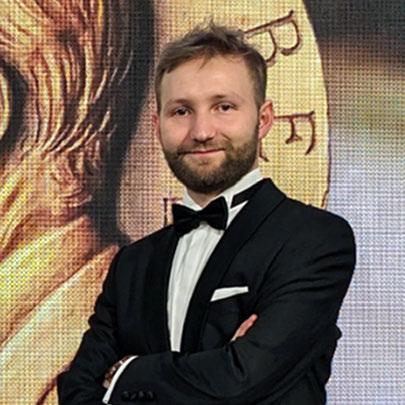
®HighPerCell Technology: A Sustainable FilamentProductionMethod
DevelopedbyDITF,HighPerCell®isacuttingedge spinning technology that enables the ecofriendly production of filaments from renewable biopolymers like hemp cellulose. The process uses ionic liquids (IL), which are non-toxic, stable, and recyclable, leading to minimal environmental impact. HighPerCell® distinguishes itself by its low-temperature, closed-loopprocess,ensuringresourceefficiency andversatilityinfeedstocks.
KeyFeatures:
· Direct dissolution of biopolymers, using non-inflammable,non-toxicsolvents.
· Low-temperature process requiring no stabilizers, ensuring minimal environmental impact.
· High adaptability to various raw materials, including hemp, for both textile and technicalapplications.
HempasaRenewableResource
Hemp offers a highly sustainable feedstock for textile production, requiring no pesticides or irrigation while significantly contributing to carbon sequestration, absorbing approximately 15 tons of CO2 per hectare. RBX Créations partners with large agricultural cooperatives and small farming groups to source hemp, ensuring 100%traceabilityandsustainability.
FranceistheleadingEuropeanproducerofhemp, with over 22,000 hectares under cultivation, making it an ideal resource for sustainable celluloseproduction.
® The Iroony Project: Advancing Hemp Filaments
The collaboration between DITF and RBX
® Créations led to the creation of the Iroony Project, which produces high-purity cellulose pulp from hemp using a patented process. This pulp is then transformed into cellulose filaments
® usingtheHighPerCell technology.Theresulting technicalfilamentsexhibitpropertiessuitablefor a wide range of applications, from high-end fashiontoindustrialuses.
Technical Properties of Hemp-Based Filaments:
· Hemp Pulp: High α-cellulose content (>91%)with<0.3%ashcontent.
· Filament Properties: Tenacity between 25-45cN/tex,titerof2.0-3.3dtex,withexcellent strengthandelongationproperties.
· Sustainable Processing: 100% dissolvable in IL, ensuring minimal environmentalimpactduringproduction.
EnvironmentalImpactandMarketViability
® TheIroony hempfilamentsofferasignificantly more sustainable alternative to conventional fibers like cotton, viscose, and oil-based fibers. Initial life cycle assessments (LCA) indicate a

much lower environmental footprint, while the filaments retain high quality and durability. The closed-loop processing system further enhances thesustainabilityofthesefilaments,aligningwith the growing market demand for eco-friendly textiles.
® TheversatilityofIroony hempfilamentsmakes themsuitableformultipleapplicationsacrossthe textileandtechnicalsectors:
· Fashion and Apparel: High-end clothing,casualwear,underwear,andfootwear.
· Home Textiles: Bedding, curtains, and upholstery.
· TechnicalTextiles:Filtration,wipes,and industrialnon-wovens.
Conclusion
The partnership between DITF and RBX Créations in the development of hemp-based cellulosicfilamentsmarksasignificantmilestone in sustainable textile production. The
®HighPerCell technology, combined with the environmentallyresponsiblecultivationofhemp, offers a scalable solution for producing highperformance,eco-friendlymaterials.Thesuccess
® of the Iroony Project underscores the potential ofhempfilamentsinmeetingthetextileindustry's dualneedforsustainabilityandquality.
ContactInformation:
· MarcVocht(DITF):marc.vocht@ditf.de
· Anne Reboux (RBX Créations): anne.reboux@iroony.net
· Charles Reboux (RBX Créations): charles.reboux@iroony.net Thisreportshowcasesthepromiseofhemp-based celluloseasacornerstoneofthefutureoftextiles, driving the industry towards more responsible, sustainablemanufacturingpractices.

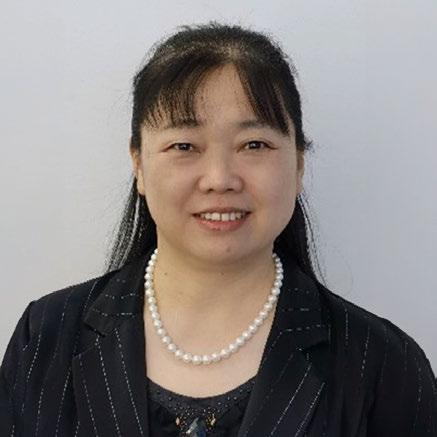
Author:
· Rui Wang (Jiangsu Guowang HighTechniqueFiberCo.Ltd.,China)
Introduction
Asenvironmentalconservationbecomesacritical concern for industries worldwide, the textile and apparel industry, which contributes approximately 10% of global industrial carbon emissions, faces an urgent need for transformation. Jiangsu Guowang HighTechnique Fiber Co. Ltd. and the Beijing InstituteofFashionTechnologyhavepioneered low-carbon and sustainable innovations within thePETfibersector.Thisreporthighlightstheir achievements in developing green technologies, focusing on carbon recycling and sustainable productionprocesses.
The textile industry is one of the largest contributors to global carbon emissions, trailing only behind the oil industry. With the increasing globalpopulation,theindustry'scarbonoutputis expected to rise, potentially surpassing other sectors in its environmental impact. Current life
cycle assessments reveal that fiber production alone accounts for 12% of the textile industry's carbon emissions, largely due to synthetic fiber production.
China dominates global chemical fiber production, with an impressive 70% share of the market. In 2023 alone, China produced 68.72 milliontonsofchemicalfibers,57.02milliontons of which were PET fibers. This production accounts for 85% of global PET fiber output, positioningChinaasapivotalplayerintheglobal fiber industry. However, this large-scale production also highlights China's responsibility intransitioningtowardalow-carbon,sustainable fiberindustry.
In response to the Chinese government's "Dual Carbon" vision—aiming to peak carbon emissionsby2030andachievecarbonneutrality by 2060—the fiber and textile industries are embracingthe circulareconomy.This approach promotes resource efficiency, environmental protection, and economic growth through
technologicalinnovation.Thegoalistoestablish a modern fiber industry that is high-end, intelligent,andgreen.
TheCarbonRecyclingProject
At the heart of Jiangsu Guowang HighTechnique Fiber Co. Ltd.'s efforts is a pioneering carbon recycling project, which captures and converts CO2 emissions into PET fibers. Collaborating with the Beijing Institute of Fashion Technology, the project focuses on thesustainabletransformationofindustrialwaste intovaluableresources.
KeyTechnologicalInnovations:
1. CO2 Capture and Purification: Industrial emissions are captured and purified to food-grade levels for further processing.
2. Chemical Conversion to Ethylene Glycol (EG): The purified CO2 is convertedintohigh-purityethyleneglycol (EG), a key raw material in PET fiber production.
3. Melt Direct Spinning: A novel productiontechniqueisemployed,where EG is polymerized with purified terephthalicacid(PTA)anddirectlyspun into PET fibers, reducing energy consumption and environmental impact comparedtotraditionalpelletspinning.
QuantifiedBenefitsofCarbonRecycling
For every 1,000 kilograms of polyester fiber produced, the process requires 335 kilograms of high-purity ethylene glycol and consumes approximately840kilogramsofCO2.Moreover, the melt direct spinning technology employed in this process reduces energy consumption by 37.4%, resulting in a 100-kilogram reduction in CO2 emissions per ton of fiber produced. This systemnotonlycreatesapathwayforsustainable fiber production but also significantly cuts down thecarbonfootprintofthetextileindustry.

FutureExpansionandSocialImpact
Currently, the project converts 120,000 tons of CO2 annually into 48,000 tons of ethylene glycol. Future plans include expanding this capacity to convert 300,000 tons of CO2 into 120,000 tons of ethylene glycol.Theprojectnot onlydemonstratessignificantenergysavingsand emission reductions but also sets a leading example for sustainable development within the textileindustry.
Thesuccessofthisinitiativeservesasamodelfor establishing sustainable supply chains and promoting low-carbon systems in textile production. By leveraging technological innovations, Jiangsu Guowang HighTechnique Fiber Co. Ltd. and BIFT are contributing to the development of industry standards and accelerating the transformation towardagreenerfuture.
Conclusion:TheNewTextileRoad
The future of the textile industry lies in lowcarbon innovation and sustainability. These advancements represent a new path for the industry, one that is driven by environmental responsibility and technological progress. The collaboration between Jiangsu Guowang HighTechniqueFiberCo.Ltd.andBeijingInstitute of FashionTechnology setsapowerfulexample fortheentiresector.Together,theyaimtoreduce carbon emissions, recycle industrial CO2, and buildabetter,moresustainableworld.
ContactInformation:
· Rui Wang (Jiangsu Guowang HighTechniqueFiberCo.Ltd.)
· BeijingInstituteofFashionTechnology, China
This report showcases the significant advancements in low-carbon PET fiber production, highlighting the role of innovative technologiesindrivingsustainabilityintheglobal textileindustry.


Author:
· MatthewSpence(SamsaraEco)
Introduction
In a world grappling with the environmental challengesposedbyplasticwaste,SamsaraEco has emerged as a groundbreaking enviro-tech companywithamissiontocreateinfiniteplastic recycling and produce green chemicals from plastic waste. Samsara Eco envisions a future where the exploitation of Earth's resources to produce new plastics becomes unnecessary.This report provides an overview of Samsara Eco's innovative technology, the path to commercializing plastic recycling, and the company'sambitiousgoalsfor2030.
Samsara Eco's Vision: Infinite Plastic Recycling
Plastic waste is one of the most pressing environmental issues today, with an estimated 9
billiontonsofplasticwastealreadyproduced.The majorityofthiswasteiseitherincineratedorends upinlandfills.SamsaraEcoaimstoreversethis trend by developing a revolutionary plastic recyclingtechnologythatenablesinfinitereuseof plasticmaterialswithoutdegradationinquality.
Samsara'sRecyclingTechnology
At the core of Samsara Eco's operations is its enzymatichydrolysistechnology,whichbreaks down plastic waste into monomers that can be repurposed to create virgin-like products. The entireprocessinvolvesfourkeysteps:
1. Plastic Waste Collection: Gathering various forms of plastic waste, including polyesterandnylonproducts.
2. Enzymatic Hydrolysis: Using specialized enzymes to break down the polymer chains of plastic waste into monomers.

3. Monomer Purification and Dye
Removal: Purifying the resulting monomerstoremoveimpuritiesanddyes, ensuringacleanoutput.
4. Repolymerization: Repurposing the purified monomers to create virginqualitypolymersfornewproducts. Thefinaloutputincludesnylon6,6andpolyester, which are reused in producing threads and garmentsincollaborationwithindustrypartners.
Samsara Eco's technology has progressed from lab-scale testing to the development of commercial facilities. The timeline for commercializationisasfollows:
· 2021: Initial lab-scale pilot lines for PET andNylon6,6weredeveloped.
· 2022-2023: Samsara launched its first batch lines with a capacity of <2kt per annum.
· 2024-2025:Thecompanyplanstoscaleits operations to a commercial plant with an annualcapacityof20kt.
· 2030: Samsara's goal is to recycle 1.5 million tons of plastic per year, saving approximately 2.5 million tons of CO2 equivalentemissionsannually.
Samsara Eco is proud to be backed by leading industry players and investors who share its commitment to sustainable innovation. The company collaborates with partners across the textile and manufacturing industries to create closed-loop systems where plastic waste is continuously recycled into new, high-quality products.
By2030,SamsaraEcoaimsto:
· Recycle 1.5 million tons of plastic waste annually.
· Prevent 2.5 million tons of CO2 equivalent emissions from entering the atmosphere.
· Further develop its green chemical production capabilities, providing alternatives to fossil fuel-derived chemicals.
Samsara Eco is committed to environmental and social responsibility, and it is proud to be a Certified B Corporation. This certification underscores the company's dedication to transparency,sustainability,andcreatingpositive environmental impacts through its innovative recyclingprocesses.
Samsara Eco is leading the charge in infinite plastic recycling, utilizing cutting-edge technology to tackle one of the world's most significant environmental challenges. By enablingtheproductionofvirgin-qualityplastics from waste, Samsara is poised to transform the plastic industry, contributing to a future where plasticwasteisathingofthepast.Withambitious goalsfor2030andbeyond,SamsaraEcoissetto play a pivotal role in achieving a truly circular economyforplastics.
ContactInformation:
· MatthewSpence(SamsaraEco)
· Website:samsaraeco.com
This report illustrates the potential of Samsara Eco's innovative recycling technology to revolutionizeplasticrecyclingandcontributetoa moresustainablefuture.

Syre:RevolutionizingTextile-to-TextileRecycling foraGreenerFuture
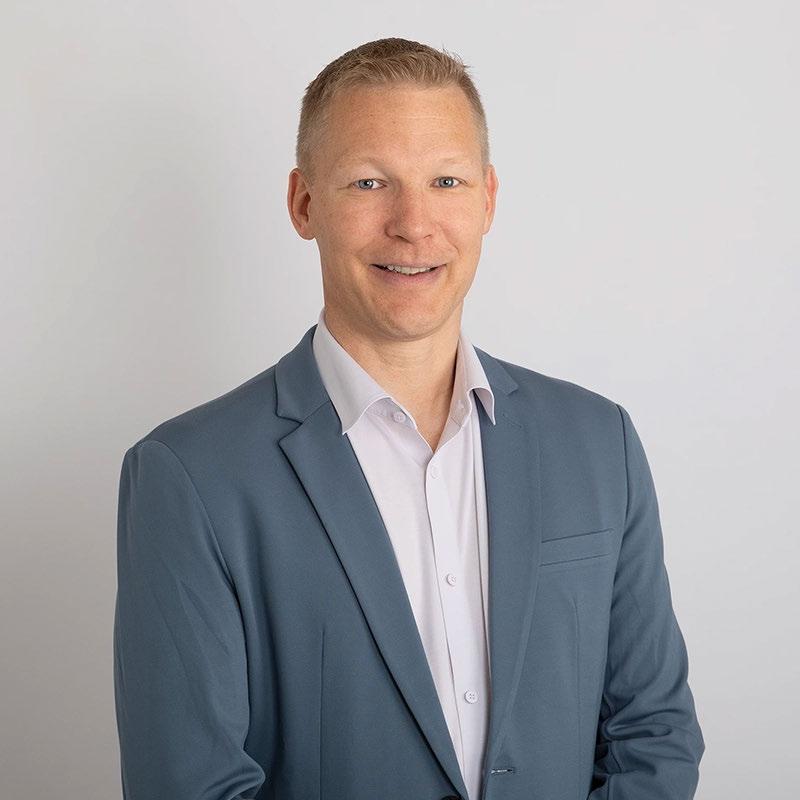
Author:
· DennisNobelius(CEO,Syre)
Introduction
As the world grapples with the growing need for sustainable solutions, Syre, under the leadership of Dennis Nobelius, emerges as a pioneer in textile-to-textile recycling at hyperscale. With a missiontodecarbonizeandminimizewasteinthe textileindustry,Syreissettoreshapethesectorby creating regional circular loops and green value chains that offer consistent quality materials comparabletovirginfibers.
Syre'sVisionandMission
Syreisnotjustarecyclingcompany;itisatextile impact company with a bold vision to decarbonizethetextileindustryandreducewaste
through innovative recycling technologies. By focusing on circular polyester recycling and leveraging cutting-edge research and development, Syre aims to deliver superior sustainabilityperformanceonaglobalscale.
BackedbyIndustryLeadersandInnovators
Syre's journey is supported by industry leaders and disruptors across various verticals. These strategic partnerships enhance its capabilities in developing sustainable technologies and scaling them globally. With a clear ambition to lead in cost,quality,andsustainability,Syre'scontinuous recyclingprocessisprotectedbytradesecretsand intellectual property (IP), ensuring competitive advantages.
TechnologyandInnovation
At the core of Syre's operations is a continuous textile-to-textile recycling process. This groundbreaking technology transforms textile wasteintohigh-qualitymaterialsthatrivalvirgin fibersinperformance.Syre'suniqueIPandtrade secrets underpin this innovation, positioning the company as a future leader in cost-effective and environmentallysustainabletextileproduction.
KeyFeatures:
· Continuous recycling process designed forscalability.
· Technology that ensures consistent quality and performance, comparable to virginmaterials.
· Innovationsthatsupportregionalcircular loops,reducingtheneedforlong-distance materialtransportation.
GlobalRolloutandExpansionPlans
Syre is actively expanding its operations, with Vietnamshortlistedforthefirstgigaplantrollout. Followingthis,theEuropeanUnion(EU)isslated for the next phase of expansion. Syre's global growth strategy is focused on establishing regional circular loops, which will contribute to reducing the carbon footprint associated with textilerecyclingandsupplychains.
ImpactatScale
Syre's vision extends beyond small-scale sustainabilityefforts.Thecompanyaimstocreate impact at scale, reshaping the global textile industrythroughlarge-scalerecyclingplantsthat process waste efficiently and at low cost. By establishing green value chains and regional recyclinghubs,Syreishelpingtocreateacircular economywithinthetextilesector.
Syre'sPillarsofImpact:
1. Textile-to-Textile Recycling: Directly transforming textile waste into usable materials.

2. Regional Circular Loops: Reducing transportation emissions by establishing localizedrecyclingfacilities.
3. Green Value Chains: Implementing sustainable practices throughout the productionprocess.
4. High-Quality Recycled Materials: Delivering materials on par with virgin fiberstoensurenocompromiseonquality.
Syre prides itself on being led by a team of scalemakers—individualswiththeexpertiseand drive to bring large-scale impact through sustainability.Thisteamisdedicatedtopropelling thetextileindustryintoaneweraofrecyclingand responsible production, with the aim of addressing both environmental and economic challengesatscale.
Conclusion
UndertheleadershipofDennisNobelius,Syreis positionedtorevolutionizethetextileindustryby integrating large-scale recycling processes with sustainable production. By focusing on creating regional circular loops, green value chains, and high-quality recycled materials, Syre is addressing the industry's most pressing environmentalconcerns.Astheglobalexpansion continues,Syreissettoleadthechargeincreating acirculareconomywithinthetextilesector.
ContactInformation:
· DennisNobelius(CEO,Syre)
· Website:syre.com
This report highlights Syre's commitment to transformingthetextileindustrythroughscalable, innovative, and sustainable recycling solutions that are set to create a lasting impact on a global scale.


The Indian Technical Textile Association (ITTA)successfullyheldits14thAnnualGeneral Meeting(AGM)on 13th September2024 atthe OrchidHotel,Mumbai.Themeetingwaschaired byShriAvinashMisar,withtheparticipationof ITTA members, special invitees, and media representatives. Dr. Anup Rakshit, Executive Director of ITTA, welcomed the distinguished guestsandmediarepresentativestotheevent.The businesssessionwasconductedbyShriMahesh Kudav,ViceChairmanofITTA.
The AGM was graced by the presence of Shri Rajeev Saxena, Joint Secretary (Textiles), MinistryofTextiles,GovernmentofIndia,asthe
Chief Guest, and Shri Virendra Singh (I.A.S.), Secretary(Textiles),GovernmentofMaharashtra, astheGuestofHonour.
Key Highlights from Shri Rajeev Saxena's Address
ShriSaxenaemphasizedthepivotalroleITTAhas played in advancing the technical textile sector and fostering innovation, sustainability, and growth. He highlighted ITTA's involvement in key government committees such as the Mission Steering Group and the Empowered Programme Committee under the National Technical TextilesMission(NTTM).

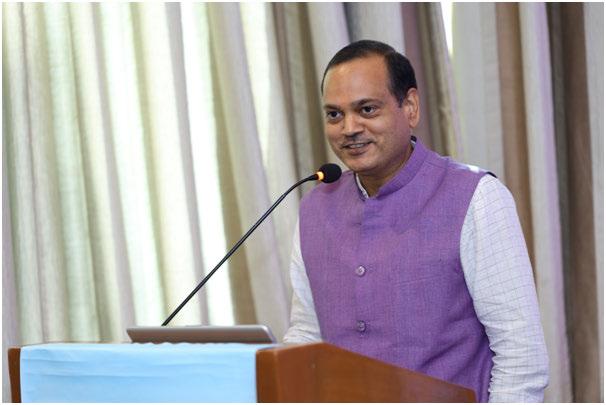
Shri Saxena mentioned that two-thirds of the investments under the Production Linked Incentive (PLI) scheme are dedicated to technicaltextiles.OftheRs.60croresallocated, Rs. 40 crores are earmarked specifically for this sector. He stressed the importance of innovation in securing the future of the industry and encouraged companies to engage in marketfocused R&D initiatives, with the government covering 90% of the costs and allowing companies to retain Intellectual Property Rights (IPR) for 3 to 4 years. He also announced the upcoming introduction of Quality Control Orders (QCOs) for 11 key technical textile products, aimed at preventing the dumping of cheap foreign products and strengthening domesticsupplychains.
Shri Saxena urged conventional textile manufacturerstodiversifyintotechnicaltextiles,
leveraging their spare capacities for enhanced productivity and profitability. He also suggested that ITTA conduct training and skill developmentprogramsinTier-2citiestofurther theindustry'stechnicalknowledge.
Maharashtra'sTextilePolicy-KeyPointsfrom ShriVirendraSingh'sPresentation
Shri Virendra Singh shared insights on Maharashtra's State Textile Policy, which prioritizes the development of six technical textile parks—one in each revenue division of the state.The policy includes substantial support intheformof:
· Infrastructuresupport
· Capitalsubsidies
· Supportforsolarpowerplants
· ZeroLiquidDischargeinitiatives
Ÿ EffluentTreatmentPlants

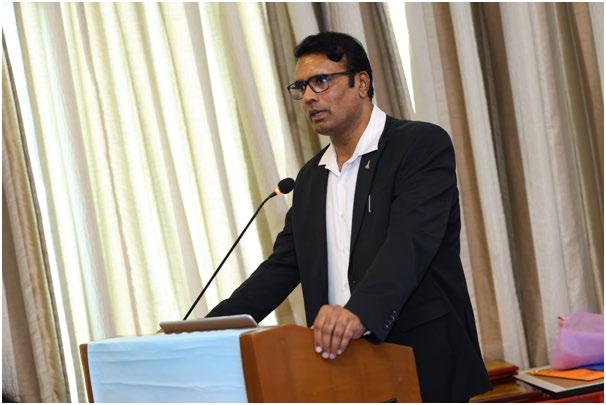
An Expression of Interest (EoI) for these parks will soon be released, and the Maharashtra Technical Textile Mission will be launched within two months. A Memorandum of
Understanding(MoU)betweentheGovernment of Maharashtra and ITTA is set to be signed to ensure the effective implementation of state policies.

ShriAvinashMisar,ChairmanofITTA, extendedhisgratitudetotheMinistryofTextiles foritscontinuedsupportofthetechnicaltextile sector.Healsourgedthegovernmenttoaddress theavailabilityofspecialtyrawmaterials,such asfibers,yarns,chemicals,andpolymers,that
arecrucialformanufacturinghigh-endtechnical textilesbutarenotproducedinIndia.He highlightedthattheQCOsshouldnotbe imposedonupstreamsectorsreliantonimported rawmaterials,asthiscouldhinderthegrowthof theindustry.


Dr.Anup Rakshit, Executive Director of ITTA, introduced two new membership categories—Associate and Student Membership—to cater to individual entrepreneurs and startups entering the technical textile industry. Additionally, ITTA has taken a focused initiative to collaborate with Academic InstitutionstoorganizeEducationandTraining Programs on technical textiles. This initiative will support the NTTM's goal of creating a skilled workforce for academic institutions and theindustry.
ITTA's Entrepreneurial Development Programs(EDPs)havesuccessfullytrainedover 200candidates,contributingtothegrowthofthe technicaltextilesector.
As the industry evolves with cutting-edge innovations, sustainability practices, and emerging technologies, Technical Textiles Innovation Magazine,Publish by Times International is set to provide the latest insights,trends,andbreakthroughs,servingas an indispensable resource for global stakeholders.


A significant highlight of the AGM was the presentation of the “Lifetime Achievement Award” to Shri Pramod Khosla, Chairman of Khosla Profil Pvt. Ltd., for his exceptional contributionstothetechnicaltextileindustry.Shri Khoslawasalsoinductedintothe 'ITTAHall of Fame', alongside Shri Yogesh Kusumgar of Kusumgar Corporates and Shri Mohan Kavrie ofSupremeNonwovens. InnovationAwards
The Innovation Awards were presented to five companies for their outstanding contributions to thetechnicaltextileindustry:
1. Garware Technical Fibres Ltd. – Shri Neeraj Shrivastava & Shri Apurv Gadekar for Advancing Sustainability: Development of ropes from recycled materials–RenewRopes.
2. SRFLtd.–Ms.AngelineDivya,Associate VicePresident,fortheDevelopmentand Commercialization of Food-Grade TankLinersmadefromcoatedfabricfor waterstorageinruralareas.
4. FibriltexPvt.Ltd.–ShriIshaanSharma, DirectorofBusinessDevelopment,forthe Flushable Biodegradable Sanitary Pads
5. IndoGermanYarn&FibresLLP–Shri RajivSajdeh,Partner,forthePROMYDE KARANW-2 WR 480 GSM Fabric –PersonalProtectionSustainable.
A Game-Changer for the Global Textile Industry
Technical Textiles Innovation Magazine, published by Times International. The magazine has been identified as a gamechanger for the global textile industry.As the industry evolves with cutting-edge innovations, sustainability practices, and emerging technologies, Technical Textiles Innovation is set to provide the latest insights, trends, and breakthroughs, serving as an indispensableresourceforglobalstakeholders.
3. High Performance Textiles Pvt. Ltd. –Dr. Nandan Kumar, Managing Director, for Innovative Inherent FlameRetardant (IFR) Fabric for arc-flash protection.



In a significant move for the global nonwovens industry, INDA (Association of the Nonwovens Industry), based in Cary, North Carolina, and EDANA (the Voice of Nonwovens), headquarteredinBrussels,Belgium,havesigned aLetterofIntent(LOI)inRome.Thisagreement marks a major step toward the exploration of a strategic alliance aimed at combining their expertise and resources to address global challenges and unlock new opportunities in the nonwovenssector.
As the nonwovens industry continues to evolve, both organizations recognize the importance of collaboration and a unified approach to navigating complex international markets. The
potential alliance between INDA and EDANA promisestobringaboutawiderangeofbenefits, focusing on enhancing member services, joint advocacy, operational synergies, and fostering innovation.
KeyObjectivesoftheStrategicAlliance:
EnhancingMemberValue:
ThealliancewillallowbothINDAandEDANAto providegreatervaluetotheirmembersbypooling resources. This integration will enable expanded educational programs, improved networking opportunities,andaccesstoamorediversesetof industry insights that will better serve members acrosstheglobe.


UnifiedAdvocacyandRepresentation:
Together,thetwoorganizationswillamplifytheir collective voice, strengthening their ability to advocatefortheirmembersatlocal,regional,and global levels. This unified approach will ensure that industry concerns and needs are addressed moreeffectively.
OperationalSynergies:
By aligning resources and talents, the strategic alliance is set to create operational efficiencies, optimizefinancialresources,andenhancesupport for industry initiatives.This move will help both organizations strengthen their collective impact ontheindustry.
DrivingInnovationandGrowth:
The alliance aims to drive collaborative projects and initiatives that promote innovation, industry leadership, and sustainable growth in the nonwovens sector. By working together, both INDAandEDANAwillhelppositiontheindustry forfuturesuccess.
LeadershipPerspectives:
Murat Dogru, General Manager of EDANA, emphasized the importance of the alliance, saying, "This Letter of Intent underscores our
commitmenttoexploringhowwecanbetterserve the nonwovens community and tackle the industry's evolving challenges. Our goal is to ensure that our members are positioned to thrive inadynamicglobalenvironment.Thesigningof thisLOIinRome,echoingthesignificanceofthe TreatyofRome,symbolizesthebeginningofeven greaterachievementsforourindustry."
INDA President & CEO Tony Fragnito echoed this sentiment, adding, “This potential alliance represents an opportunity to combine our strengths and address global issues more effectively. By coordinating our efforts, we can better serve the industry while maintaining a regionally focused approach to support and representation.”
Overthecomingmonths,INDAandEDANAwill conduct a thorough due diligence process to evaluate the strategic benefits and operational efficiencies of this potential alliance. Both associationsremaincommittedtoadvancingtheir members' interests and identifying new avenues forgrowthwithinthenonwovensindustry.
As discussions progress, both organizations will provide further updates on the developments of thisexcitinginitiative.

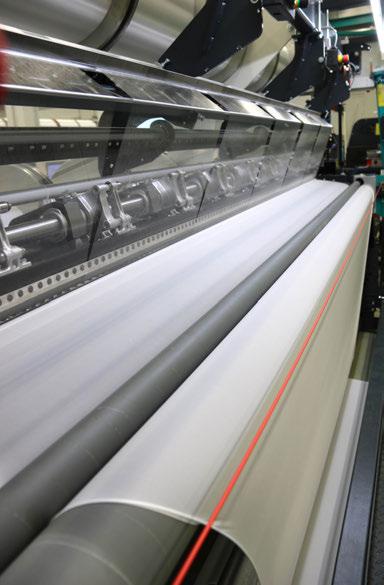
At ITMA ASIA + CITME 2024, the KARL MAYER GROUP will focus on its innovative warp knitting solutions, designed to meet the challenges of a rapidly evolving market. Under thetheme"MastertheChange,"KARLMAYER willdemonstratehowitshigh-techmachinesand digital platforms can help customers adapt to volatilemarkets,reducelaborneeds,andenhance profitability.
AkeyhighlightwillbetheunveilingoftheHKS 2-S in the new gauge E 44, a high-performance tricotmachinecapableofproducingupto200kg offabricdaily,idealforthegrowingoutdoorwear market. Alongside this, visitors can explore a range of warp knitting innovations, including stylishyogawear,sustainablecasualfabrics,and sunprotectionclothing.
In addition to the advanced machinery, KARL MAYER will present its digital solutions, includingthemyKM.ONCustomerPortalandthe AI-driven Quality Monitoring System (QMS), which offer real-time production insights. A special in-house show in Changzhou will further showcase seven warp knitting machines, emphasizing the company's technological leadership.
From cutting-edge textiles to digital efficiency, KARLMAYER's exhibit promises to be a mustseeforanyoneinthewarpknittingindustry.

Monforts recently celebrated its 140th anniversary at a special event for staff and their familiesatitsheadquartersinMönchengladbach,Germany.Buildingonaveryrichhistory sinceitsfoundationbyAugustMonfortsin1884,thecompanyremains100%dedicatedtothe development of technologies that will ensure the future success of its textile industry customers.

The first Monforts machines were mechanical napping units for raising the surfaces of cotton fabrics.
Under the motto, '140 Years of Performance, Innovation and Partners', Monforts is looking forwardtofurthercelebratingthismilestonewith its representatives and customers at the forthcoming ITMAAsia + CITME exhibition in Shanghai from October 14-18, in Hall 5 at stand C09.
“Wehavemovedoverthemanydecadesthrough mechanical and steam-powered technologies to the first mass production lines, electronic drives, specialmachineconstructionandhighlymodular machines,” observes Monforts Managing DirectorGunnarMeyer.“Nowwearetrulyinthe digitalage,andwearecommittedtoinvestingin thedigitalizationofourtechnology,withconcepts whichassureanoverallqualitycontrolandenergy monitoring.”
The first Monforts machines were mechanical napping units for raising the surfaces of cotton fabrics, providing softness and warmth and adding value. By 1893, Monforts 24-roller napping machines were drawing appreciative crowdsattheWorldFairinChicago–establishing internationaltradenetworkswasparamounttothe companyfromtheoutset.
In 1897, August Monforts established an iron foundry equipped with hydraulic casting machines,bywhichtimethecompanyemployed 1,200 people. This was followed by the introduction of semi-automatic manufacturing tools – an area in which Monforts achieved a number of firsts, such as the single-spindle lathe which became a big export hit in the late 1930s duetoitsuniqueandunmatchedprecision.

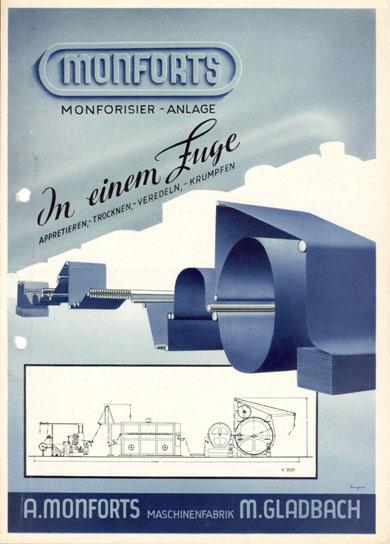
The company's range of textile machines has been significantly expanded based on decades of accumulated know-how and a dominant position in fabric finishing technologies has been established
Overseen by successive four generations of the Monforts family, the company's range of textile machines has been significantly expanded based on decades of accumulated know-how and a dominantpositioninfabricfinishingtechnologies hasbeenestablished.
Since 2013, Monforts has been a member of the CHTC Fong's Group, today one of the world's largesttextilemachinerymanufacturers.
MonfortsMontexstenters–forprocessessuchas drying, stretching, heat-setting and coating – are nowtheindustrystandardforthefabricfinishing industry, not only in the sectors of denim and home textiles, but also in the field of technical textiles,withnumerouspatentsregisteredoverthe course of the decades for premium quality and a number of advantages in terms of production throughput and especially in energy efficiency
and savings. The other key technologies in the MonfortsrangeincludeDynAirrelaxationdryers, Thermex continuous dyeing ranges, Monfortex compressiveshrinkingrangesandMontex®Coat andcoaTTexcoatingunits.
Since its opening in 2013, the €2.5 million MonfortsAdvancedTechnologyCentre(ATC)in Mönchengladbach has proved an invaluable resource to customers for achieving new standardsinfabricfinishing.
Overanareaof1,200squaremetres,ithousestwo full finishing lines, engineered to accommodate an extremely diverse range of processes, in addition to a Thermex range for the continuous dyeing of denim and other woven fabrics, a full colourkitchenandanumberoflab-scalesystems forsmallerbatchtrials.


“TheATCallowsourcustomerstotesttheirown textilesandtechnicalfabricsonMonfortsdyeing and finishing machines under fully confidential, real production conditions,” says Monforts Technologist Saskia Kuhlen. “Using the results from these trials, we are also able to make recommendations for improving many fabric finishes.”
MontexAustria
For over 40 years, Monforts finishing machines have been manufactured at Montex MaschinenfabrikbasedinSt.Stefan,Austria.
“From the outset, we have specialised in all aspects of machine production, including highprecision sheet metal working, laser cutting and welding, and the pre-assembly of machines and components, along with a well-organised quality management and spare parts service,” says Montex plant manager Gert Hanzl. “We work very closely with the Monforts research and development team in Mönchengladbach to take the latest new ideas through testing and prototyping, in readiness for future series production.Wearefullyexploitingthemanynew possibilities in the continuous development of designandmanufacturingmethods.”
Whilethereisstandardisationinseries-produced Monforts machines, Montex Maschinenfabrik is alsoincreasinglycalledupontoconstructbespoke machines with unique designs, according to the special needs of customers in technical textile or specialtextiles.
Madetolast
“Ourmachinesarebuilttolastandknownfortheir robustness and long service life,” concludes GunnarMeyer.“Textilecompaniesmakingmajor capital investments in new manufacturing lines relyondurabilityfromourproductionranges,and it's for this reason that there are currently an estimated 2,000 Monforts machines in operation worldwide – some of which were first installed over30yearsago.
“ItwouldnothavebeenpossibleforMonfortsto have thrived for 140 years without successfully and rapidly responding to industry changes and this continues today. I would like to thank all of our dedicated staff in Germany and Austria and our many colleagues and partners around the world for their continuous contributions to ensuringourfurtherlongevity.”



Atthisyear'sCINTETechtextilfairinShanghai, DILO received the innovation award for its intensive needling technology “MicroPunch”. Recentdevelopmentsinenergycosts,particularly for electricity and gas, and given the increasing shortageofwaterresources,haveledtoashiftin thinking over the past few years. Together with economic efficiency, the evaluation of the environmental impact of production has become increasinglyimportant.
For DILO, this meant focusing once again on needling technology for the fine and lightweight nonwoven sector over the last years. The individual elements of the intensive needling technology were re-examined and underwent a complete revision. It became clear that the high productionratescouldonlybeachievedusingthe two-dimensional kinematics of the needle beam of "HyperPunch" or "CycloPunch." The necessary high feed rates of around 50 mm per stroke, coupled with the highest stitching densitiestoachievegoodabrasionresistance,led toaneedofasignificantincreaseofthenumberof needles and needle density—almost doubling from approximately 20,000 needles/meter/board to around 45,000 needles/meter/board. It also became obvious that ensuring a high efficiency rate in production also required the careful
attentiontoaquickassemblyoftheneedleboards withneedlemodules.Acompletelynewapproach was needed in the design and construction of the needle boards to enable rapid module exchange andachieveaveryhighmechanicalprecision.
Previously, needling technology was primarily used for a surface weight range starting at 100 g/m² up to several kilograms per m². The expansion into the range below 100 g/m², and potentially down to 30 g/m², now completes the applicability of needling technology. The intensive needling technology "MicroPunch" opensupaneconomicalfieldforawidevarietyof lightweight nonwoven fabrics that can be produced by a pure mechanical processes. The productcharacteristicsachieved,suchasabrasion resistance, are comparable to those of hydroentangeldnonwovens.Needledfabricstend to have more volume and more stretch while offering similar tensile strength values. These special quality characteristics are particularly interestingforapplicationsinhygiene,medicine, cosmetics,andfortechnicalproducts.
With this new development, the energy required to produce lightweight nonwoven fabrics has beenreduceduptoapproximately75%compared tootherbondingtechnologiesofthissegment.
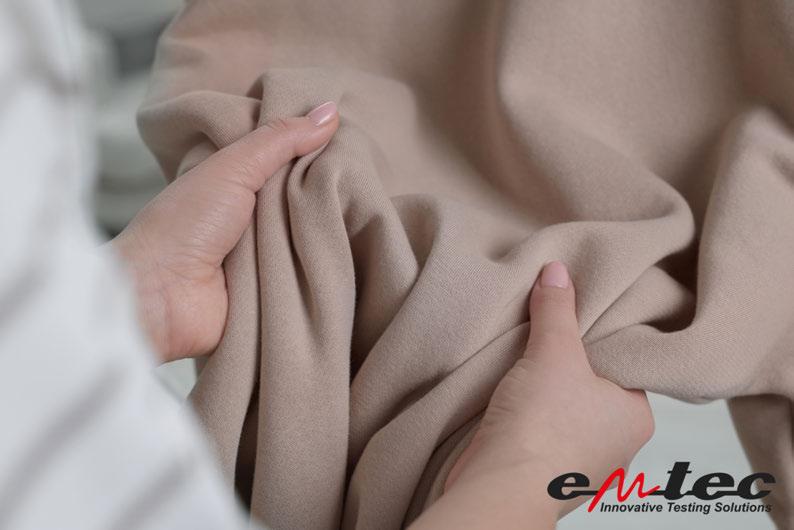
Emtec Electronic, a leader in innovative textile testing solutions, is set to showcase its revolutionary TSATactile SensationAnalyzer at the Taipei Innovative Textile Application Show (TITAS)2024fromOctober15-17.Inpartnership with GO-IN International Co., Ltd., emtec will demonstrate how the TSA is reshaping the way textilehapticsaremeasured.
Recognized with the Techtextil North America Innovation Award 2024, the TSA offers precise, objectivemeasurementsofkeyhapticparameters, suchassurfacesoftness,smoothness,stretch,and recoverybehavior,allwithinjust90seconds.This is a major leap from traditional hand-panel testing, providing unmatched accuracy and efficiency.
The latest enhancements to the TSA include thermal property measurements, advanced springback behavior assessments, and an
integrated high-resolution camera for detailed imaging. These upgrades push the boundaries of hapticevaluationfortextilesandnonwovens.
A standout feature is the TSA's integration with thecloud-basedVirtualHapticLibrary,developed with Black Swan Textiles. This online database enables real-time access to digital haptic data, streamliningsupplychainsandreducingtheneed forphysicalsamples.
“The TSA Tactile Sensation Analyzer is setting newbenchmarksinthetextileindustry,”saidEric Haagen,GlobalBusinessDevelopmentatemtec. “AtTITAS2024,welookforwardtoshowcasing how our cutting-edge technology elevates precision in quality assurance while improving supplychainefficiency.”
Visit emtec at booth N3-709 to explore this innovativesolution.


InterviewwithStefanLux,ManagingDirectorofKM.ON, abouthiscompany'spresentationatITMAASIA+CITME2024
KM.ON will also be presenting exciting digital solutions for more customer benefits in the warp knittingandflatknittingindustryattheupcoming ITMAASIA+CITME.Anyonewhowantstoget toknowthemwillhavetwoopportunitiestodoso: at the KARL MAYER GROUP stand in Hall 4/C27 at the Shanghai National Exhibition and Convention Centre and at an in-house show at KARL MAYER (CHINA) in Changzhou to accompanythetradefair.
Stefan Lux, the new Managing Director of KM.ON, and his team are looking forward to welcoming their guests. ITMAASIA + CITME 2024isthefirsttradefairthattheITspecialistwill beinchargeofinhisnewposition.KatrinFromm, Marketing Manager at KM.ON, spoke to Stefan
Lux about his expectations and the digital exhibits.
KF: What is the motto of KM.ON's presentation attheupcomingITMAASIA+CITME?
SL: We share the KARL MAYER GROUP's motto'MastertheChange'withourexhibition.At KM.ON,weunderstandthechallengesthatmany inthetextileindustryarefacingrightnow.Rising costs,rapidlychangingmarketdemands,andthe increasing need for sustainable practices are putting a lot of pressure on businesses. We're excitedtobeatITMAASIAthisyearbecauseit's the perfect opportunity to show how our digital solutions can make a real difference in our customers' operations. We're all about helping
them get more out of their current setup by enhancing efficiency, boosting productivity, and reducingcosts.
KF: Let's look at warp knitting first. What solutions do you provide to help customers becomemoreefficient,moreprofitableandmore sustainable?
SL:WehavetheDigitalProductionManagement (DPM) and the Quality Monitoring System (QMS) in our trade fair baggage for our warp knitting customers. The DPM gives real-time insightsintoproductionprocesses.Withthistool, our customers can monitor their operations live, make quick decisions, identify and fix issues faster,andminimizedowntime.It'saboutkeeping productionsmoothandefficient.
TheQMShelpsmaintainqualityatthehighest level as a key factor for success. The system works with an AI-powered camera system that inspectseveryinchoffabricduringproduction.If it detects various production anomalies like defects, it stops the process and alerts the team immediately. On top of that, we provide unmatchedrobustnessagainstanythingthatcould causeafalsestop.
KF: These solutions therefore offer concrete support in day-to-day production. Are such tools and systems also available for flat knitting?
SL:WithourPPSpoweredbySTOLL,wehelp ourflat knitting customers to plan and adjust their production quickly. This is crucial given thedynamicnatureoftoday'smarkets.PPSisa production planning tool that enables the

customer to control and optimize operations. It helps reduce lead times and respond to market changes swiftly, all accessible from any device, anytime,anywhere.
CREATE PLUS & CREATE DESIGN is also about speed: accelerating the design and development process for flat knitwear.
CREATE PLUS is our programming software with advanced and faster project management, while CREATE DESIGN digitalizes the design process, allowing for realistic simulations and quickertimetomarket.
KF: KM.ON is therefore well prepared forits trade fair guests. What do you expect from ITMAASIA+CITME?
SL:Iexpectfruitfuldiscussionsaboutnewideas and innovative solutions at ITMA ASIA. The textileindustryisfacingmajorchallengesandwe, KM.ON as a member of the KARL MAYER GROUP, want to be part of the solution. The digitallandscapeisdevelopingrapidlyandoffers new opportunities. As software specialists, we always have ourfingeron the pulse. We don't just want to present our innovative solutions; we want to have real discussions with our customers and partners about how we can support them today and tomorrow with our digital solutions. Together, we want to find practical ways to drive growth, optimize existing systems and remain competitive in a rapidlyevolvingmarket.
Iinviteeveryonetovisitusatourboothandtojoin our digital journey to master the challenges of textileindustrytogether.
BW




Building on its groundbreaking partnership with MonfortsandArchroma,BaldwinTechnology,abrand of BW Converting, will empower textile manufacturerstotaketheleadinsustainablefinishing withitsTexCoat™G4precisionspraysystematITMA Asia 2024, Stand H5A29, October 14-18, at the National Exhibition and Convention Center in Shanghai,China.
Given the current global economy's cost sensitivity andtherisingemphasisonsustainabilityfrombrands, consumers and regulatory bodies, there is a growing demand for eco-friendly textile production methods. Baldwin's team will be on hand at ITMA Asia to discuss how its technology aligns with the sustainability and carbon footprint objectives of the textilesupplychain,allwhileenhancingperformance andreducingcosts.
Baldwin’sTexCoat G4 non-contact spray technology presentsmultipleadvantagesovertraditionalfinishing methods. It revolutionizes the traditional water- and energy-intensive pad-dry-cure finishing process by precisely applying chemistry including softeners, antimicrobials, durable water repellents, flame retardants, resins and most other water-based chemicals across the textile surface only where it is required,ononeorbothsidesofthefabric.Thesystem can therefore reduce water, chemistry and energy consumptionbyupto50%comparedtotraditionalpad applicationprocesses.Itutilizesthesamechemicalsas conventional pad baths without needing special additives.
AtITMAAsia,visitorswillhavetheopportunitytosee the technology up-close and experience a diverse selection of fabric samples with finishes that were applied with TexCoat G4, sourced from textile mills worldwide.
“In 2024, Baldwin has enjoyed amazing success in Asia with the adoption of TexCoat G4 with multiple new installations in Bangladesh, China, India and Pakistanjusttonameafew,”saidRickStanford,Vice President of Global Business Development, Textiles, BW Converting. “Factory owners are investing in TexCoat G4 because it is the right thing to do for the planet and it pays for itself in short order through water,chemicalandenergysavings. Everybodywins withTexCoatG4.”
Baldwin’s recently announced collaboration with Monforts and Archroma further amplifies its commitment to sustainable textile finishing. This partnership merges Monforts’ state-of-the-art finishing equipment, Archroma’s leading-edge chemistries, and Baldwin’s TexCoat G4 spray technology to deliver next-generation sustainable solutions. Together, the three companies will support dyeing and finishing manufacturers, a critical part of thetextilesupplychain,intheirdevelopmentprojects, boostingthequalityandperformanceoftheirfinished products, while at the same time maximizing the productivity and resource utilization of the finishing applicationprocess.
Formoreinformation,visitbwconverting.com.

